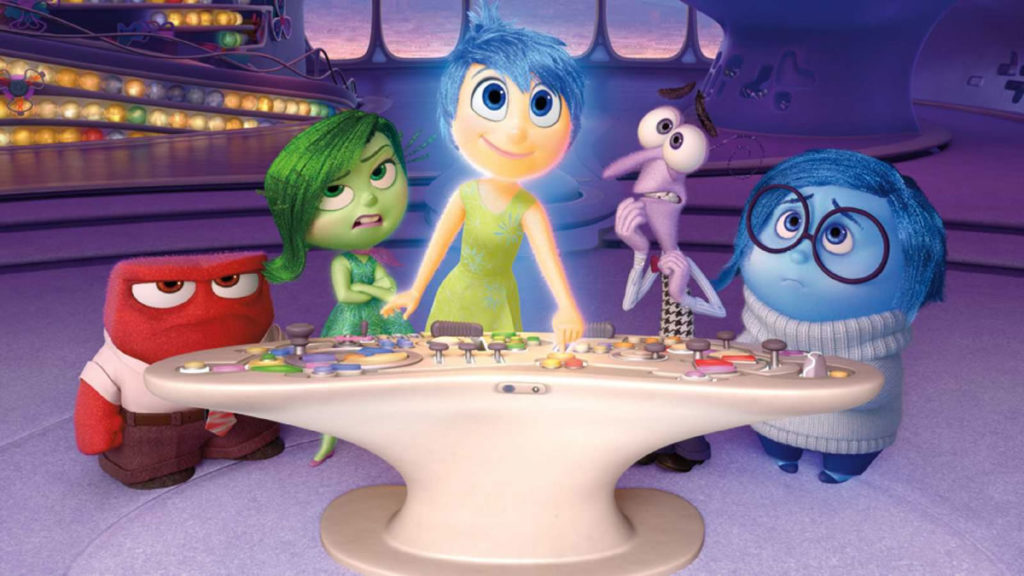We need all of our emotions to think, solve problems, and pay attention. We are neurobiologically connected, and to learn something our minds must be focused and our emotions must “feel” in balance . Emotional regulation is necessary for us to remember, retrieve, transfer, and connect all new information to what we already know. When a continuous flow of negative emotions takes over our frontal lobes, the architecture of our brain changes leaving us in an elevated state of response to stress where fear, anger, anxiety, frustration and sadness take over our thinking, the “logical brain”.
The Inside Out movie is an exceptional and accurate representation of our top five emotions. These primary emotions are joy, sadness, fear, anger, and disgust . This movie describes how we use these emotions when difficult and happy experiences arise, and how we need negative emotions as well as positive ones. After reviewing the science behind Inside Out, we wanted to develop research-based educational neuroscience strategies, questions, and assessment ideas aligned with some scenes from the film.

So in this post we will explore four categories that represent the conceptual and developing brains of all children and adolescents. There is no recipe for successful implementation of the strategies and each will be based on the level at which they are being applied. Consequently, they may vary in aspects such as the necessary preparation time of the teacher, the class time or, mainly, in the enthusiasm that is used.
What is neuroplasticity and how does it affect feelings?
Neuroplasticity is the brain’s ability to reconnect our circuits, strengthening existing pathways between neurons that are exercised and used, and weakening the connections between cellular pathways that are not used. Reconnecting our brain circuits depends on experience, but we can change the synapses or connections that are activated by changing a perception or behavior.
Neuroplasticity includes rethinking or re-evaluating an experience, event, or relationship so that we observe and experience a different outcome . In other words, what we perceive and expect is what we get because the brain sees and responds to perception, not reality. Negative brain states can become neural traits that are also connected to our circuits.
In this sense, the processes that support emotional intelligence are addressed in the growing field of interpersonal neurobiology. The theory behind this field provides a picture of human mental development and the transformative potential that exists by changing thinking and processing of emotions, thoughts, and behaviors. The concept of emotional intelligence is interrelated with interpersonal neurobiology and the development of conscious awareness as a strategy to achieve a healthy integration of emotional, psychological, physiological and cognitive functioning.
In the movie Inside Out we are presented with the central memories. All of us constantly create memories, but what makes them central or meaningful are the emotions we attach to those past events, experiences, and relationships. Emotions direct our attention and perception and we form positive and negative central memories due to the emotional intensity that we have associated with the event or experience.

We work on emotions with the help of the movie Inside Out
The film also introduces us to the world of emotions when we see how they mix in the brain of Riley, the 11-year-old protagonist girl. Her happy core memories are represented by golden balls, and at the beginning of the movie, Riley’s sadness interferes with those golden balls of joy-filled memories. When a central golden memory is touched by sadness, the gold fades, turns a deep blue, and joy is frustrated. Later, through Riley’s various experiences, we learn that shades of blue and gold that represent sadness and joy can work well together, weaving a beautiful contrast to create a lasting core memory. These core memories are stored “long term” and eventually become part of our Islands of Personality or also known as Islands of Being.
The following questions are designed to ignite and empower creativity and thought processes in class as topics and standards are integrated:
Questions for teachers to ask in the process
- What types of core memories could you create in your school with students and teachers? These memories can be emotional, academic, or social, reflecting a new relationship, a novel way of trying a task, or a collaborative project with others.
- How can we create core memories that energize, awaken curiosity, and bring joy to students?
- Are you teaching students about their neuroanatomy?
- Do students understand the negative role stress plays on cognitive functioning with respect to learning, memorizing, and retrieving information?
- How could we start a class period or day with an emotional record? “What is the weather in our brain”? Could we use laminated note cards with the primary emotions for younger students and the primary and secondary emotions for older students? Students can show the feeling they have when class begins and observe how it changes throughout the day.
Sample questions to ask students
These questions are designed to promote discussion among students, self-reflection, and self-awareness. Sadness helped Joy in the movie, and our own sadness can help us too.
- What happened when Alegría and Tristeza left headquarters?
- How do you see the joy in your brain?
- What creates joy to take over your brain?

- How do you deal with sadness?
- Can you use your sadness to feel better? How?
- What if we never felt sad? Is it sometimes good to keep sadness within a circle so that it doesn’t spread and get out of control? Why?
- Fear and anger can protect and motivate us. When was fear necessary in your life?
- How did fear help you?
- What is the perfect amount of fear?
- What happens to our thinking and problem-solving skills when we carry too much fear or sadness?
- How does anger appear in your brain?
- Has anger ever helped you?
- How do you handle your anger?
- Disgust prevents us from being physically and socially poisoned. How has the feeling of disgust helped you?
- How has expressing disgust affected your relationships or experiences?
- In the movie, Joy plays the main role among the feelings in Riley’s brain. Does Joy always play the main role in our brain?
- Imagine having no feelings at all. What would life be like if we didn’t have feelings? Describe two positive changes in our life if we did not have feelings.
- Describe two negative changes that could occur in a life without feelings.











































































































